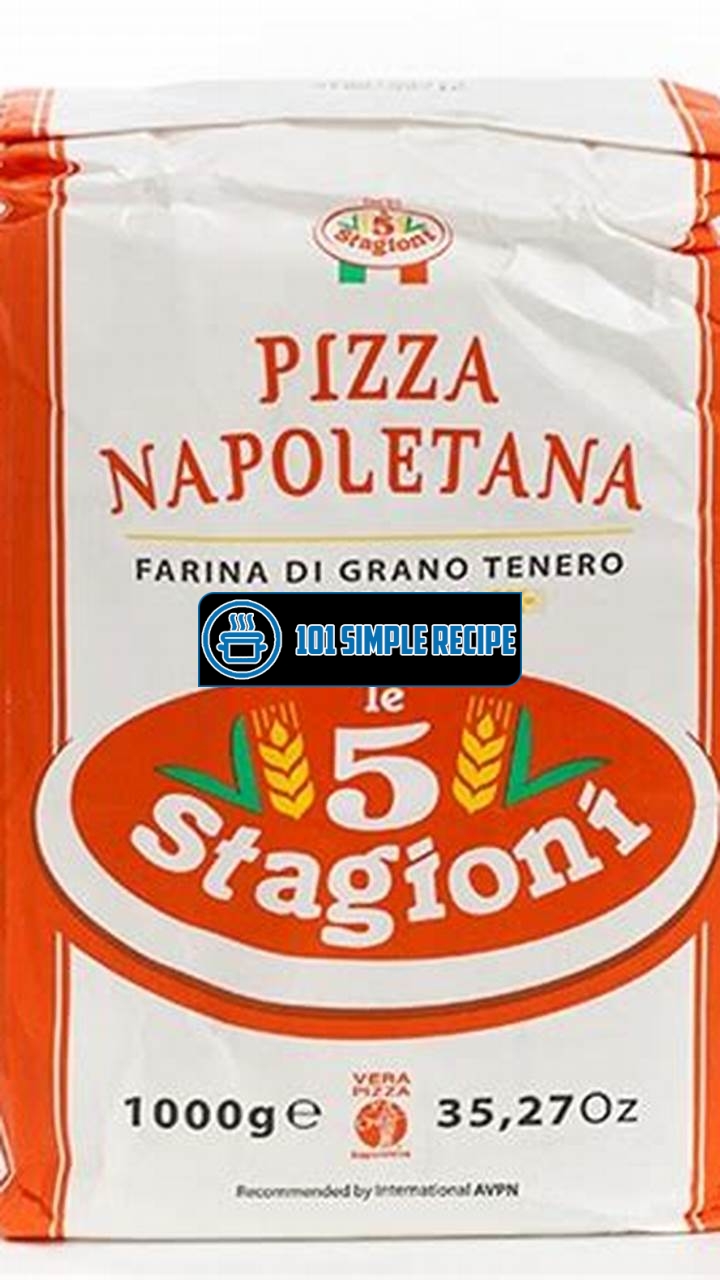If you’re a pizza lover, then you know there’s nothing quite like sinking your teeth into a slice of the iconic Pizza Napoletana. But what is it that makes this Neapolitan-style pizza so authentically delicious? It all starts with the flour. In this article, we’ll delve into the world of pizza flour and uncover the best types to achieve that truly authentic taste and texture. So get ready to discover the secret behind the perfect crust as we explore a range of flours that will elevate your homemade pizzas to a whole new level.

Understanding Pizza Napoletana
Pizza Napoletana is a traditional Italian pizza style that originates from Naples, Italy. It is known for its thin and crispy crust, fresh and flavorful toppings, and traditional cooking methods. To truly appreciate and enjoy Pizza Napoletana, it’s important to understand its origins and characteristics.
History of Pizza Napoletana
The history of Pizza Napoletana dates back to the late 18th century when it was first created in Naples, a bustling port city in Southern Italy. It was initially a humble street food that catered to the working class. The Neapolitan people, known for their resourcefulness, developed this simple and delicious food that quickly became a local favorite.
Pizza Napoletana gained popularity beyond Naples in the 19th century when Queen Margherita of Italy visited the city. Legend has it that she grew tired of the French cuisine and asked for a local dish to be made for her. A local pizza maker named Raffaele Esposito prepared a pizza with fresh tomatoes, mozzarella cheese, and basil, representing the colors of the Italian flag. Queen Margherita loved it, and thus, the Margherita pizza was born.
Key Ingredients of Pizza Napoletana
The key ingredients of Pizza Napoletana are simple yet essential for achieving its authentic taste and texture. The dough is made with high-quality wheat flour, water, salt, and natural yeast. The type of flour used is crucial to achieve the desired texture and flavor of the crust.
Caputo Tipo 00 Flour: One of the best flours for Pizza Napoletana is Caputo Tipo 00 flour. This finely ground flour has a high protein content, which contributes to a tender and chewy crust. It also has a low gluten content, resulting in a lighter and more easily digestible pizza.
The other important ingredient is San Marzano tomatoes, which are grown in the volcanic soil of Mount Vesuvius. These tomatoes are known for their sweet and tangy flavor, making them ideal for Pizza Napoletana’s simple yet delicious tomato sauce.
Other key ingredients include fresh mozzarella cheese made from buffalo milk, extra virgin olive oil, fresh basil leaves, and a sprinkle of sea salt. These ingredients work together to create a harmonious flavor profile that is distinctively Pizza Napoletana.
Authenticity Requirements for Pizza Napoletana
For a pizza to be truly considered Pizza Napoletana, it must adhere to certain authenticity requirements set by the Associazione Verace Pizza Napoletana (AVPN). These requirements include:
- Using specific ingredients, such as Caputo Tipo 00 flour, San Marzano tomatoes, and fresh mozzarella made from buffalo milk.
- Following specific dough preparation techniques, including hand-mixing the dough and allowing it to rise for a specific duration.
- Cooking the pizza in a wood-fired oven at a high temperature for a short period, resulting in a blistered crust and perfectly melted toppings.
Note: It’s important to note that not all pizzerias labeled as “Neapolitan-style” or “Naples-style” pizza strictly adhere to these authenticity requirements. To ensure you are getting an authentic Pizza Napoletana, look for pizzerias certified by the AVPN.
In conclusion, Pizza Napoletana is a beloved Italian pizza style that has a rich history and unique characteristics. Understanding its origins, key ingredients, and authenticity requirements allows you to appreciate the craftsmanship and flavors that make it truly special. Whether you’re indulging in a classic Margherita or exploring other traditional toppings, Pizza Napoletana is sure to satisfy your cravings for an authentic Italian culinary experience.
white castle recipe is a classic burger that is loved by many. It is known for its unique flavor and slider size. If you want to try making your own white castle burgers at home, check out our easy recipe.
The Role of Flour in Pizza Napoletana
Flour plays a fundamental role in creating the perfect crust for Pizza Napoletana. This traditional Neapolitan pizza is known for its soft, chewy, and thin crust that achieves a delicate balance of crispiness and lightness. The choice of flour greatly impacts the texture, flavor, and overall quality of the pizza dough.
.
Characteristics of Pizza Napoletana Flour
Pizza Napoletana flour is carefully selected to meet specific characteristics. It is typically made from soft wheat varieties, which have a lower protein content compared to bread flour. The protein content in the flour determines the gluten formation during mixing and kneading, impacting the elasticity and structure of the dough.
For an authentic Pizza Napoletana, the flour should have a protein content ranging from 10% to 12%. This protein level promotes a softer, more tender crust. Additionally, the flour should have a high ash content, which indicates a higher mineral content. This contributes to the distinct flavor and color of the crust.
Note: Choosing the right type of flour is crucial in achieving the desired texture and taste of Pizza Napoletana.
Types of Flour for Pizza Napoletana
There are several types of flour suitable for making Pizza Napoletana, each with its own unique characteristics. The most commonly used types include:
- 00 Flour: This is the most popular and traditional choice for Pizza Napoletana. It has a fine texture and low protein content, resulting in a soft and delicate crust.
- Caputo Flour: Caputo is a renowned Italian brand known for its high-quality flour. The “Caputo Pizzeria” and “Caputo Cuoco” varieties are specifically designed for making Neapolitan-style pizza.
- American Bread Flour: Some pizzaiolos prefer using American bread flour, which has a higher protein content and creates a chewier crust. However, this may deviate from the traditional characteristics of Pizza Napoletana.
Criteria for Choosing the Best Flour
When selecting the best flour for Pizza Napoletana, consider the following criteria:
- Protein Content: Opt for flour with a protein content between 10% and 12% to achieve the desired tenderness in the crust.
- Ash Content: Look for flour with a higher ash content, indicating a richer flavor and color.
- Origin: Choose flour made from high-quality wheat, preferably from Italy, as it ensures authenticity and captures the essence of traditional Pizza Napoletana.
By carefully selecting the flour and understanding its characteristics, you can elevate your Pizza Napoletana experience by achieving a crust that is both authentic and delicious. ✨
Caputo Flour: The Gold Standard
When it comes to creating an authentic Pizza Napoletana, one ingredient stands above the rest: Caputo flour. This renowned flour is the gold standard for pizza makers around the world, known for its exceptional quality and ability to create the perfect Neapolitan-style pizza crust.
The History of Caputo Flour
Caputo flour has a rich history that dates back to 1924, when the Caputo family began producing flour in Naples, Italy. Over the years, they have perfected their milling techniques and selection of grains to create a flour that is ideal for pizza making. The Caputo family’s passion for high-quality flour has been passed down through generations, ensuring that each bag of Caputo flour upholds their legacy of excellence.
The Different Varieties of Caputo Flour
Caputo offers a variety of flours, each specially formulated for different types of pizza. One popular option is the Caputo “00” flour, which is the traditional choice for making Pizza Napoletana. This finely ground flour has a low gluten content and high protein content, resulting in a light, airy crust that is crispy on the outside and chewy on the inside.
For those looking for a gluten-free option, Caputo has developed their Fioreglut flour. This flour is made from a blend of rice and potato starch, providing a gluten-free alternative that still delivers a delicious crust.
Caputo also offers flours specifically designed for different cooking methods. Their Pizzeria flour is perfect for wood-fired ovens, while their Chef’s flour is ideal for longer fermentation periods and colder temperatures.
Tips for Working with Caputo Flour
Working with Caputo flour requires some adjustments compared to other flours. Here are a few tips to ensure success:
- Hydration: Caputo flour absorbs water differently, so it’s essential to adjust the hydration level. Start with a lower amount of water and gradually add more until you reach the desired consistency.
- Longer Fermentation: Caputo flour benefits from longer fermentation periods, allowing the dough to develop more complex flavors. Consider letting your dough rise overnight in the fridge.
- Higher Oven Temperature: Caputo flour performs best at high temperatures. Preheat your oven as hot as possible to achieve a beautifully charred crust.
- Gentle Handling: The delicate gluten structure of Caputo flour requires gentle handling. Avoid over-kneading the dough to prevent it from becoming tough.
By following these tips, you can fully unlock the potential of Caputo flour and create the most authentic Pizza Napoletana right in your own kitchen.
best flour for pizza napoletana is an essential ingredient that can make or break your pizza. The right flour will give your pizza dough the perfect texture and flavor. Check out our comprehensive guide to find the best flour for your pizza napoletana recipe.
Alternative Flours for Pizza Napoletana
When it comes to making an authentic Pizza Napoletana, choosing the right flour is essential. While traditional Neapolitan pizza dough requires a specific type of flour, there are several alternative options that can be used to achieve a delicious crust. In this article, we’ll explore these alternatives and discuss their unique qualities.
Using Semolina Flour
Semolina flour is a coarsely ground flour made from durum wheat. It is commonly used in pasta making, but it can also be an excellent choice for Pizza Napoletana. The coarse texture of semolina flour adds a delightful crunch to the crust, while its high protein content helps create a chewy yet light texture.
Key Points:
- Semolina flour adds a crunchy texture to Pizza Napoletana crust.
- Its high protein content creates a chewy yet light texture.
- Commonly used in pasta making, semolina flour is a versatile option.
Experimenting with Whole Wheat Flour
If you prefer a healthier twist to your Pizza Napoletana, consider using whole wheat flour. Whole wheat flour contains all parts of the wheat kernel, providing essential nutrients and a nutty flavor. While it may take some experimentation to perfect the dough, using whole wheat flour can result in a heartier crust with a distinct taste.
Key Points:
- Whole wheat flour adds essential nutrients and a nutty flavor.
- Experimentation may be required to achieve the desired texture.
- Whole wheat flour creates a heartier crust with a distinct taste.
Gluten-Free Options for Pizza Napoletana
For those with gluten sensitivities or dietary restrictions, there are gluten-free flour options available. These flours are typically made from a combination of non-gluten grains and starches, such as rice flour, tapioca flour, and potato starch. While gluten-free dough can be more challenging to work with, it is possible to achieve a tasty and satisfying Pizza Napoletana crust.
Key Points:
- Gluten-free flours are suitable for individuals with gluten sensitivities or dietary restrictions.
- They are typically made from non-gluten grains and starches.
- Creating a gluten-free Pizza Napoletana crust may require additional techniques.
In conclusion, while traditional Neapolitan pizza dough relies on a specific type of flour, there are alternative options available for those looking to experiment and add a unique twist to their Pizza Napoletana crust. Semolina flour can provide a crunchy texture, whole wheat flour offers a nuttier flavor, and gluten-free flours cater to individuals with specific dietary needs. Each option brings its own characteristics to the table, allowing you to personalize your Pizza Napoletana experience.
pizza dough recipe is the foundation of a good pizza. King Arthur flour is known for its high quality and consistency, making it a popular choice for pizza dough. Try our King Arthur pizza dough recipe for a delicious and authentic pizza crust.
Mastering the Art of Dough Preparation
When it comes to crafting an authentic Pizza Napoletana, one of the most crucial elements is the dough. The perfect dough creates the foundation for a delicious and traditional Neapolitan-style pizza. To achieve this, it is essential to delve into the techniques and tips for preparing the ideal dough. By mastering the art of dough preparation, you will be well on your way to creating the best Pizza Napoletana.
Fermentation and Proofing Process
The fermentation and proofing process is a crucial step in dough preparation that cannot be overlooked. This process allows the yeast in the dough to interact with the sugars, creating carbon dioxide gas that gives the dough its light and airy texture. To ensure proper fermentation and proofing, follow these important tips:
- Use high-quality yeast: Start with a reliable yeast that is suitable for pizza dough. This will help ensure consistent results.
- Allow enough time: Fermentation and proofing can take anywhere from 6 to 24 hours, depending on the desired flavor and texture. Give the dough enough time to rise and develop its unique characteristics.
- Control temperature: Maintain a consistent temperature during fermentation and proofing. This can be achieved by placing the dough in a warm room or using a proofing box.
Kneading and Stretching Techniques
The next step in dough preparation is kneading and stretching. These techniques help develop gluten, which gives the dough its elasticity and structure. To master kneading and stretching, consider the following:
- Kneading: Start by combining the ingredients and kneading the dough until it is smooth and elastic. This can be done by hand or with the help of a stand mixer. Kneading helps distribute the yeast and develop gluten.
- Stretching: Once the dough is properly kneaded, it’s time to stretch it. Gently stretch the dough by hand, using your fingertips to press it out from the center to the edges. This will create the traditional thin and slightly chewy crust of Pizza Napoletana.
- Practice: Kneading and stretching may require some practice to perfect. Don’t be discouraged if your first attempts are not as successful as you hoped. With time and practice, you will develop the skills needed to create the ideal dough.
Achieving the Ideal Dough Consistency
The ideal dough consistency is a balance between lightness and chewiness. Achieving this delicate balance can be a challenge, but with attention to detail, it is possible. Consider the following tips:
- Hydration level: The amount of water added to the dough affects its consistency. Adjust the hydration level to achieve the desired texture. A higher hydration level will result in a lighter crust, while a lower hydration level will create a chewier crust.
- Proper measurements: Accurate measurements of flour and other ingredients are essential for achieving the ideal dough consistency. Use a kitchen scale to ensure precision.
- Resting time: After kneading and stretching, allow the dough to rest for a sufficient amount of time. This rest period allows the gluten to relax and the flavors to develop further.
In conclusion, mastering the art of dough preparation is essential for creating an authentic Pizza Napoletana. By paying attention to fermentation and proofing, kneading and stretching techniques, and achieving the ideal dough consistency, you can elevate your homemade pizzas to a whole new level. Experiment with different flours, practice your skills, and soon you’ll be serving up delicious Neapolitan-style pizzas in the comfort of your own home. Buon appetito!
Thank you for taking the time to read this article on the best flour for Pizza Napoletana. We hope that you found the information helpful and informative. If you have any further questions or would like to learn more about this topic, please feel free to visit our website again in the future. We will continue to provide you with the latest and most relevant information on all things related to cooking and baking. Until then, happy pizza-making!
Frequently Asked Questions
Here are some frequently asked questions about the best flour for Pizza Napoletana:
| No. | Questions | Answers |
|---|---|---|
| 1 | What is the best type of flour for making Pizza Napoletana? | The best type of flour for making Pizza Napoletana is Tipo 00 flour. It is finely ground and has a high protein content, which gives the pizza dough its characteristic chewy texture and crispy crust. |
| 2 | Where can I buy Tipo 00 flour? | Tipo 00 flour is available at most specialty grocery stores and Italian markets. You can also find it online on various websites that sell baking ingredients and gourmet food products. |
| 3 | Can I use all-purpose flour instead of Tipo 00 flour? | While you can use all-purpose flour as a substitute for Tipo 00 flour, the texture and taste of the pizza crust will be slightly different. All-purpose flour has a lower protein content, which results in a less chewy and crispy crust. However, it can still be used to make delicious pizza. |
| 4 | Do I need to use a pizza stone when baking Pizza Napoletana? | Using a pizza stone is highly recommended when baking Pizza Napoletana. The pizza stone helps to distribute heat evenly and absorb moisture from the dough, resulting in a crispy and evenly cooked crust. |
| 5 | Is it necessary to let the dough rise before making Pizza Napoletana? | Yes, allowing the dough to rise is an important step in making Pizza Napoletana. It helps to develop the gluten and allows the yeast to ferment, which gives the dough its airy and light texture. |
| 6 | Can I freeze pizza dough made with Tipo 00 flour? | Yes, you can freeze pizza dough made with Tipo 00 flour. Simply wrap the dough tightly in plastic wrap and place it in an airtight container or freezer bag. When you’re ready to use it, thaw the dough in the refrigerator overnight and allow it to come to room temperature before shaping and baking. |
Get Ready to Make the Perfect Pizza Napoletana!
Now that you know all about the best flour for Pizza Napoletana, it’s time to put your newfound knowledge to use and start making delicious pizzas at home. Don’t forget to experiment with different toppings and flavors to create your own unique pizza creations. Whether you’re hosting a pizza party or simply craving a homemade slice, using the right flour will ensure that your pizza dough is perfectly chewy and crispy. So go ahead, gather your ingredients, and get ready to impress your friends and family with your pizza-making skills. Happy baking!
Jump to Recipe
Best Flour for Pizza Napoletana

Learn about the best flour for making Pizza Napoletana and how it affects the texture and taste of the pizza crust. Find out where to buy Tipo 00 flour and get answers to frequently asked questions.
- 500 g Tipo 00 flour
- 325 ml water
- 10 g salt
- 5 g active dry yeast
- In a large bowl, mix the flour and salt. In a separate bowl, dissolve the yeast in warm water and let it sit for 5 minutes. Add the yeast mixture to the flour and mix until a sticky dough forms. Knead the dough on a lightly floured surface for 5-7 minutes, until smooth and elastic. Place the dough in a greased bowl, cover with a clean kitchen towel, and let it rise in a warm place for 1-2 hours, or until doubled in size.
- Preheat your oven to the highest temperature (usually 500°F or 260°C) and place a pizza stone in the oven. On a lightly floured surface, divide the dough into 4 equal portions. Working with one portion at a time, gently stretch and shape the dough into a round circle, about 10-12 inches in diameter. Transfer the shaped dough onto a pizza peel or baking sheet lined with parchment paper. Add your desired toppings and slide the pizza onto the preheated pizza stone. Bake for 8-10 minutes, or until the crust is golden brown and crispy. Remove from the oven, let it cool for a few minutes, and then slice and serve.






